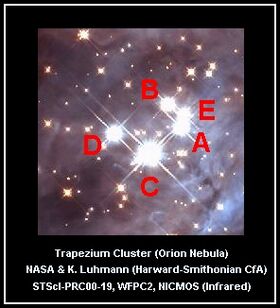Astronomy:Theta1 Orionis E
| Observation data Equinox J2000.0]] (ICRS) | |
|---|---|
| Constellation | Orion |
| Right ascension | 05h 35m 15.773s[1] |
| Declination | −05° 23′ 10.02″[1] |
| Apparent magnitude (V) | 11.40 - 11.81[2] |
| Characteristics | |
| Evolutionary stage | PMS[3] |
| Spectral type | G2 IV[4] |
| Variable type | Eclipsing[3] |
| Astrometry | |
| Radial velocity (Rv) | 34.3[5] km/s |
| Proper motion (μ) | RA: 1.45±0.03[6] mas/yr Dec.: 1.02±0.08[6] mas/yr |
| Parallax (π) | 2.557 ± 0.051[6] mas |
| Distance | 1,280 ± 30 ly (391 ± 8 pc) |
| Absolute magnitude (MV) | +1.43[7] |
| Orbit | |
| Period (P) | 9.89520 ± 0.0007[4] days |
| Semi-major axis (a) | 34.430 ± 0.193[3] R☉ |
| Eccentricity (e) | < 0.001[4] |
| Inclination (i) | 73.7 ± 0.9[3]° |
| Semi-amplitude (K1) (primary) | 84.2 ± 1.2[4] km/s |
| Semi-amplitude (K2) (secondary) | 84.6 ± 1.3[4] km/s |
| Details | |
| A | |
| Mass | 2.807 ± 0.048[3] M☉ |
| Radius | 7.1[7] R☉ |
| Luminosity | 29[8] L☉ |
| Temperature | 6,000[3] K |
| Rotational velocity (v sin i) | 37[8] km/s |
| B | |
| Mass | 2.797 ± 0.048[3] M☉ |
| Radius | 7.1[7] R☉ |
| Luminosity | 29[8] L☉ |
| Temperature | 6,000[3] K |
| Rotational velocity (v sin i) | 37[8] km/s |
| Age | 500[8] Myr |
| Other designations | |
| Database references | |
| SIMBAD | data |
θ1 Orionis E (Latinised as Theta1 Orionis E) is a double-lined spectroscopic binary located 4' north of θ1 Orionis A in the Trapezium Cluster. The two components are almost identical pre-main-sequence stars in a close circular orbit, and they show shallow eclipses that produce brightness variations of a few tenths of a magnitude.

Each component of the binary system is slightly under 3 M☉. Although they have a subgiant spectral classification, they are still contracting onto the main sequence and are estimated to be only about 500 million years old.[8] It is estimated that they will reach the main sequence as smaller hotter late-B stars.[7]
The variability was first reported in 1954[2] and confirmed as an eclipsing binary in 2012. It has not been assigned a variable star designation but is listed in the New Catalogue of Suspected Variable Stars.[2]
References
- ↑ 1.0 1.1 Cutri, Roc M.; Skrutskie, Michael F.; Van Dyk, Schuyler D.; Beichman, Charles A.; Carpenter, John M.; Chester, Thomas; Cambresy, Laurent; Evans, Tracey E. et al. (2003). "VizieR Online Data Catalog: 2MASS All-Sky Catalog of Point Sources (Cutri+ 2003)". CDS/ADC Collection of Electronic Catalogues 2246: II/246. Bibcode: 2003yCat.2246....0C. http://vizier.u-strasbg.fr/viz-bin/VizieR?-source=II/246.
- ↑ 2.0 2.1 2.2 Kukarkin, B. V.; Kholopov, P. N.; Artiukhina, N. M.; Fedorovich, V. P.; Frolov, M. S.; Goranskij, V. P.; Gorynya, N. A.; Karitskaya, E. A. et al. (1981). "Catalogue of suspected variable stars. Moscow, Acad. Of Sciences USSR Shternberg,1951 (1981)". Nachrichtenblatt der Vereinigung der Sternfreunde E.V. (1981). Bibcode: 1981NVS...C......0K.
- ↑ 3.0 3.1 3.2 3.3 3.4 3.5 3.6 3.7 3.8 Morales-Calderón, M.; Stauffer, J. R.; Stassun, K. G.; Vrba, F. J.; Prato, L.; Hillenbrand, L. A.; Terebey, S.; Covey, K. R. et al. (2012). "YSOVAR: Six Pre-main-sequence Eclipsing Binaries in the Orion Nebula Cluster". The Astrophysical Journal 753 (2): 149. doi:10.1088/0004-637X/753/2/149. Bibcode: 2012ApJ...753..149M.
- ↑ 4.0 4.1 4.2 4.3 4.4 Costero, R.; Allen, C.; Echevarría, J.; Georgiev, L.; Poveda, A.; Richer, M. G. (2008). "The Escaping Spectroscopic Binary θ^1 Ori E". IV Reunión Sobre Astronomía Dinámica en Latino América (Eds. C. Allen 34: 102. Bibcode: 2008RMxAC..34..102C.
- ↑ Olivares, J.; Sánchez, L. J.; Ruelas-Mayorga, A.; Allen, C.; Costero, R.; Poveda, A. (2013). "Kinematics of the Orion Trapezium Based on Diffracto-Astrometry and Historical Data". The Astronomical Journal 146 (5): 106. doi:10.1088/0004-6256/146/5/106. Bibcode: 2013AJ....146..106O.
- ↑ 6.0 6.1 6.2 Kounkel, Marina et al. (2017). "The Gould's Belt Distances Survey (GOBELINS) II. Distances and Structure toward the Orion Molecular Clouds". The Astrophysical Journal 834 (2): 142. doi:10.3847/1538-4357/834/2/142. Bibcode: 2017ApJ...834..142K.
- ↑ 7.0 7.1 7.2 7.3 Herbig, G. H.; Griffin, R. F. (2006). "Θ1 Orionis E as a Spectroscopic Binary". The Astronomical Journal 132 (5): 1763. doi:10.1086/507769. Bibcode: 2006AJ....132.1763H.
- ↑ 8.0 8.1 8.2 8.3 8.4 8.5 Huenemoerder, David P.; Schulz, Norbert S.; Testa, Paola; Kesich, Anthony; Canizares, Claude R. (2009). "X-Ray Emission and Corona of the Young Intermediate-Mass Binary θ1 Ori E". The Astrophysical Journal 707 (2): 942–953. doi:10.1088/0004-637X/707/2/942. Bibcode: 2009ApJ...707..942H.
 |


